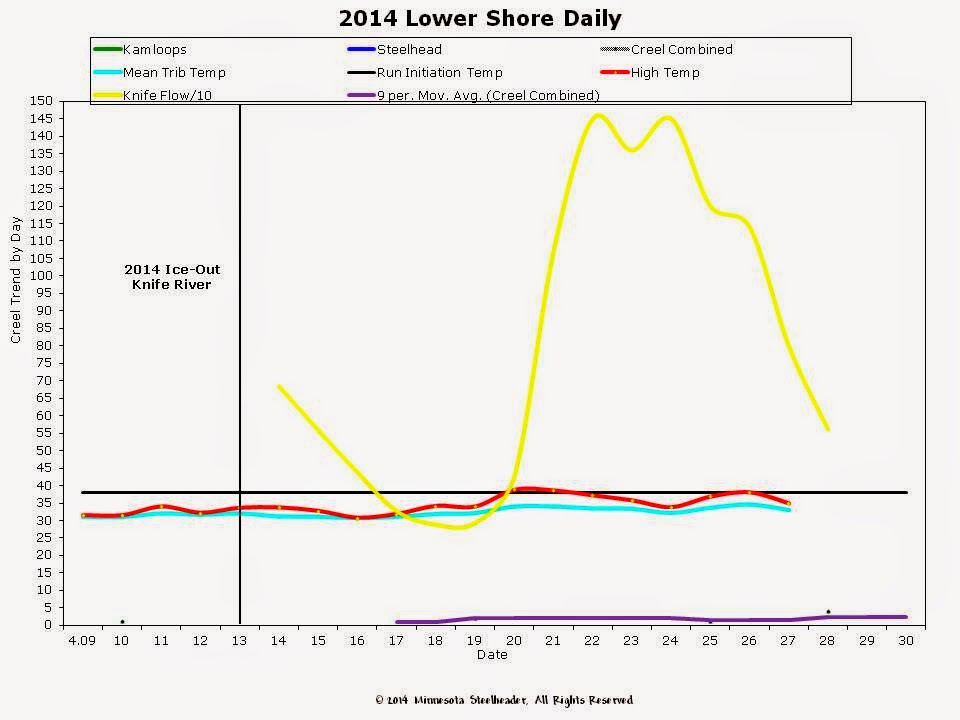2014 Creel Analysis
Well, I've been scrambling to try and find at least ONE data source for temps on the Lower Shore. THE problem has been the havoc wreaked by the 2012 floods on the in-stream data packages. It's important to have these sources because it helps us show you some of those relationships between temperature, flows and our steelhead fishery.
What's really interesting is watching how the stream temperatures change the daily fishing dynamic in that stage right before things really kick off. We know from the DNR technical literature and historical trap data that there is a temperature threshold which seems to initiate upstream migration of adult steelhead. In kamloops, that threshold is just slightly lower.
What we're trying to illustrate here is the catch trend against the stream temperatures. We won't be as concerned with flows until after that initiation temp threshold is met and maintains. Once we get past that point, it's all about the flow. Certainly temps play a big part at that stage with respect to where in the stream you'll find fish, but we are not there yet.
Here's the picture of recent conditions: Yellow line is Knife River daily flow divided by 10 for the purposes of finer illustration. Red line is daily high temps in our index stream. Blue line is daily average temps. Black line is the temperature initiation threshold for that first big migration push in adult steelhead. Purple line is the creel/catch trend as reported by the DNR and Minnesota Steelheader's creel project.
Couple items to note: It's tough to illustrate it given the raw flow numbers (even when divided by 10), but you see the temps climbing as flow drops after ice-out. Air temps at that time were high which caused a lot of cold runoff to dump into the streams from snowmelt; this in turn caused temps to tank. As flow is dropping again, stream temps are trying to creep back up there, but we need some clear sky and sun to move things along again. Preferably not too warm or we'll get another massive dump from melting snow and temps will tank; not to mention we'll all be battling the chocolate yeti...
Creel trends are essentially flat-line. There are fish around, but it's tough sledding unless you have the time to put in and fish every day. What we are looking for now is for the daily average stream temps (blue line) to get above the initiation threshold. If daily stream temp highs (red line) exceed and maintain above 40 degrees as well, so much the better.
We've never claimed to be able to predict when the run will start in any given year, but so far, watching the temp trends on an annual basis early in what you might call the pre-run stage, would be about as close as it gets. We'll post more about this as more data comes in.
Regards-
NMF
What's really interesting is watching how the stream temperatures change the daily fishing dynamic in that stage right before things really kick off. We know from the DNR technical literature and historical trap data that there is a temperature threshold which seems to initiate upstream migration of adult steelhead. In kamloops, that threshold is just slightly lower.
What we're trying to illustrate here is the catch trend against the stream temperatures. We won't be as concerned with flows until after that initiation temp threshold is met and maintains. Once we get past that point, it's all about the flow. Certainly temps play a big part at that stage with respect to where in the stream you'll find fish, but we are not there yet.
Here's the picture of recent conditions: Yellow line is Knife River daily flow divided by 10 for the purposes of finer illustration. Red line is daily high temps in our index stream. Blue line is daily average temps. Black line is the temperature initiation threshold for that first big migration push in adult steelhead. Purple line is the creel/catch trend as reported by the DNR and Minnesota Steelheader's creel project.
Couple items to note: It's tough to illustrate it given the raw flow numbers (even when divided by 10), but you see the temps climbing as flow drops after ice-out. Air temps at that time were high which caused a lot of cold runoff to dump into the streams from snowmelt; this in turn caused temps to tank. As flow is dropping again, stream temps are trying to creep back up there, but we need some clear sky and sun to move things along again. Preferably not too warm or we'll get another massive dump from melting snow and temps will tank; not to mention we'll all be battling the chocolate yeti...
Creel trends are essentially flat-line. There are fish around, but it's tough sledding unless you have the time to put in and fish every day. What we are looking for now is for the daily average stream temps (blue line) to get above the initiation threshold. If daily stream temp highs (red line) exceed and maintain above 40 degrees as well, so much the better.
We've never claimed to be able to predict when the run will start in any given year, but so far, watching the temp trends on an annual basis early in what you might call the pre-run stage, would be about as close as it gets. We'll post more about this as more data comes in.
Regards-
NMF




Comments